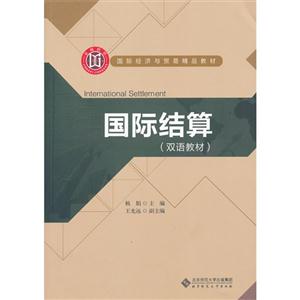国际结算-双语教材
内容简介
[
《国际结算·双语教材》以国际商会的惯例或出版物为基础,全面系统地介绍了与国际结算相关的单据、票据、融资、主要结算方法(如汇款、托收、信用证),其他结算方法(保函、保理、福费廷等)以及贸易术语等内容。不仅概括性地介绍了当前国际结算比较前沿的理论,还引入了一些前沿性的实务操作案例。特别是对在信息技术的支持下出现的电子支付工具、电子单证等都进行了阐述。
]
目录
chapter 1 introduction (learning objectives) 1 1.1 the concept of international settlement 1.2 the categories of international settlement 1.3 the risks involved in international settlement 1.3.1 product production and transport risks 1.3.2 credit risks 1.3.3 adverse business risks 1.3.4 political risks 1.3.5 financial risks 1.3.6 foreign exchange risks 1.4 parties and their roles 1.5 the application of international payment 1.5.1 payment in advance 1.5.2 credit transactions 1.5.3 collection 1.5.4 letter of credit (l/c) 1.5.5 letter of guarantee and standby l/c 1.6 evolution of international payment 1.6.1 from cash settlement to instruments settlement 1.6.2 from direct payment between traders to payment effectedthrough a financial intermediary 1.6.3 from goods trading to documents trading 1.6.4 from paper documentary settlement to electronic documentarysettlement 1.7 international rules and practicechapter 2 international payment and clearing system (learning objectives) 2.1 payment system 2.1.1 e-commerce payment system 2.1.2 clearing process 2.2 swift 2.2.1 introduction 2.2.2 characteristics 2.2.3 types of swift message 2.3 some major payment system 2.3.1 chips 2.3.2 fedwire 2.3.3 chaps 2.3.4 target 2.4 correspondent banks in international settlement 2.4. 1 banking institutions 2.4.2 correspondent bank 2.4.3 depository bankschapter 3 instruments of international settlement(learning objectives) 3.1 an overview of negotiable instruments 3.1.1 definition of a negotiable instrument 3.1.2 chief features of a negotiable instrument 3.1.3 parties to a negotiable instrument 3.1.4 negotiable instrument laws 3.2 bill of exchange 3.2.1 definition of a bill of exchange 3.2.2 contents of a bill of exchange 3.2.3 parties to a bill of exchange 3.2.4 classification of bill of exchange 3.2.5 acts relating to a bill of exchange 3.3 promissory note 3.3.1 definition of a promissory note 3.3.2 parties & characteristics of a promissory note 3.3.3 contents of a promissory note 3.3.4 classification of promissory:note 3.3.5 difference between a bill and a note 3.4 check 3.4.1 definition of a check 3.4.2 contents & features of a check 3.4.3 parties to a check 3.4.4 classification of check 3.4. 5 check clearing & dishonor 3.4.6 difference between a check and a bill of exchange 3.5 other negotiable instruments (summary) (case study)chapter 4 remittance/50 (learning objectives) 4. 1 outlines of remittance 4.1.1 definition of a remittance 4.1.2 parties to a remittance 4.1.3 types of remittance 4.2 procedure of remittance and comparison of m/t, t/t, andd/d 4.2.1 procedure of remittance 4.2.2 comparison of m/t, t/t, and d/d 4.3 reimbursement of remittance cover and refund 4.3.1 reimbursement of remittance cover 4.3.2 cancel the remittance or refund the imbursement 4.4 the function of remittance in international trade 4.4.1 payment in advance 4.4.2 payment after arrival of goods (summary) (case study)chapter 5 collection (learning objectives) 5.1 outlines of collection 5.1.1 definition of a collection 5.1.2 parties to a collection 5.1.3 types of collection 5.2 documentary collection practice 5.2.1 procedures of documentary collection 5.2.2 terms of releasing documents 5.2.3 collection instruction 5.2.4 liabilities and disclaimers of banks 5.3 risk protection and financing under collection 5.3.1 risk and protection for exporters and importers 5.3.2 financing under the collection (summary) (case s
封面

书名:国际结算-双语教材
作者:杨娟 主编
页数:341
定价:¥34.0
出版社:北京师范大学出版社
出版日期:2012-05-01
ISBN:9787303142187
PDF电子书大小:71MB 高清扫描完整版
